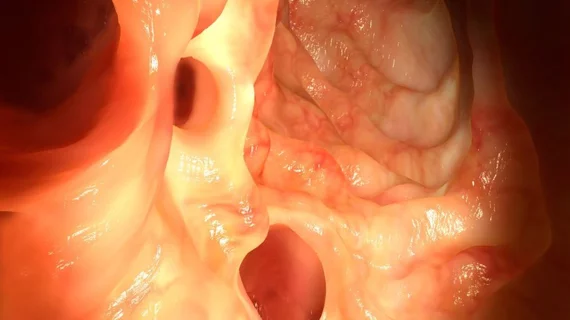Machine-learning algorithm improves polyp detection during colonoscopies
Researchers are hopeful a newly-developed machine-learning algorithm can be used to improve the detection of benign polyps during colonoscopies following a recent study validating the method.
The machine-learning algorithm was developed using more than 5,545 images from the colonoscopy reports of 1,290 patients, while it was validated on four independent datasets, according to a press release from Shanghai Wision AI, which develops computer-aided diagnostic algorithms and systems.
The validation of the first dataset of more than 27,000 images revealed the algorithm has a per-image sensitivity of 94.4 percent and a per-image specificity of 95.9 percent. In a subset of 1,280 images with polyps that were considered hard to detect, the algorithm has a per-image sensitivity of 91.7 percent.
For the second database of more than 600 colonoscopy images, it had a per-image sensitivity of 88.2 percent; and for the third dataset, it had a per-image sensitivity of 91.6 percent among 60,914 video frames and a per-polyp sensitivity of 100 percent. For the fourth dataset, the algorithm reported a per-image specificity of 95.4 percent among more than 1 million video frames.
“By using a multi-threaded processing system, the algorithm can process at least 25 frames per second with a latency of 76.80 (milliseconds) in real-time video analysis,” the study said. “The software may aid endoscopists while performing colonoscopies, and help assess differences in polyp and adenoma detection performance among endoscopists.”
Shanghai Wision AI conducted the study with clinicians at the Center for Advanced Endoscopy at Beth Israel Deaconess Medical Center (BIDMC), Harvard Medical School and the Sichuan Academy of Medical Sciences & Sichuan Provincial People’s Hospital. The full results were published in Nature Biomedical Engineering.
The detection and removal of precancerous polyps through colonoscopies is key for preventing colon cancer. However, the detection rate of benign polyps can vary significantly among endoscopists, while adenoma miss rate in the United States ranges from 6 to 27 percent, the company stated.
“Previous studies have shown that every one percent increase in the rate of detecting precancerous polyps results in a three percent decrease in the risk of interval colon cancer,” Tyler Berzin, MD, co-director of GI Endoscopy at BIDMC and Harvard Medical School assistant professor, said in a statement.
“This underscores the importance of accurate polyp detection. The encouraging results obtained using Wision AI demonstrate that a novel deep-learning algorithm can automatically detect polyps during colonoscopy, opening new doors to increasing the effectiveness of screening colonoscopy and enabling a new quality control metric that may improve endoscopy skills.”

